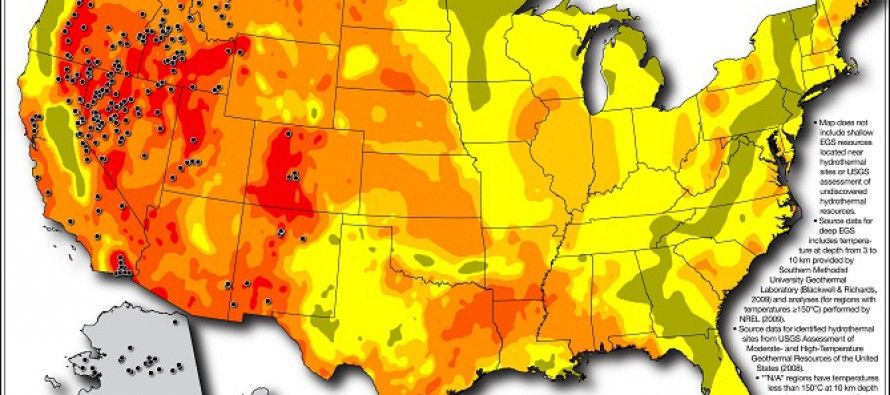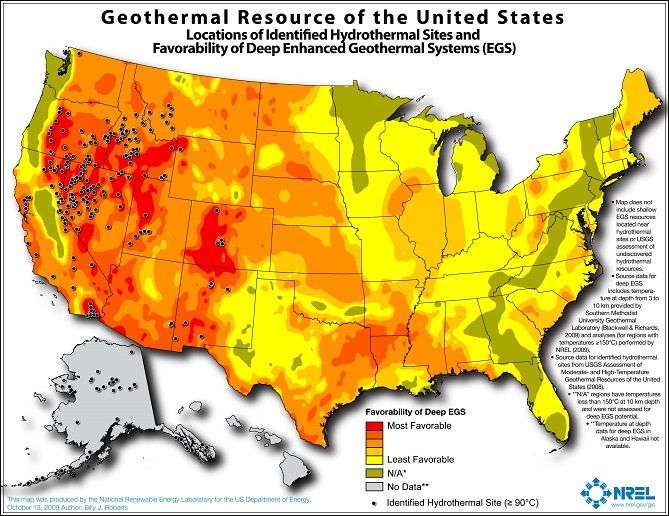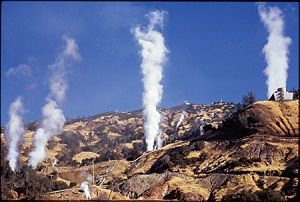Geothermal: New front in CA fracking war

 The war over fracking in California could soon have a second front.
The war over fracking in California could soon have a second front.
The Economist has become the latest publication to document how the newly refined and improved energy exploration technique using precisely aimed underground water cannons works not just to free up previously inaccessible oil and natural gas but for climate-friendly geothermal resources as well.
Depending on your point of view, hydraulic fracturing — or “fracking” — is either the future of clean, natural gas or an environmental apocalypse. Fracking liberates gas trapped underground by drilling sideways from vertical well-shafts into horizontal layers of shale rock. Millions of gallons of a cocktail of water, sand and chemicals are injected into the horizontal wells at high pressure, fracturing the shale, releasing the gas — and causing violent protests in Europe and parts of America.
Geothermal energy, by contrast, has yet to stir much controversy. Most geothermal plants are located where water has seeped down into the Earth’s crust, been heated and forced back up through permeable rock. Drill a well to between 3,000 and 12,000 feet, and the searing water and steam can be released to drive generators.
Geothermal is a minnow among power sources. America has the world’s highest installed capacity of geothermal generating plants—3.4 gigawatts’ worth at last count (see first chart) — but they generate only 0.4% of its electricity (see second chart). New “enhanced geothermal systems” (EGS), however, look set to make geothermal a bigger contributor — and potentially as controversial as shale.
The industry may dislike the comparison, but EGS is geothermal fracking. Millions of gallons of water and chemicals are injected into mostly vertical wells at relatively high pressure, and the combination of cold-meets-hot, pressure and chemistry shears the deep, hot rock. This creates new “fracture networks” through which water can be pumped, heated and sent back to the surface to generate power. Conventional geothermal wells cost at least $5m to develop, and about half fail. The new technique can reduce the failure rate and extend the size and life of existing geothermal fields. In time, think EGS fans, it will allow geothermal fields to be established wherever there is suitable hot rock.
Who knew? CA has world’s largest geothermal plant
 This is much bigger news for California than you may think. While the fact is not well known, the state has the world’s largest commercial geothermal operation at The Geysers in Lake and Sonoma counties northeast of San Francisco.
This is much bigger news for California than you may think. While the fact is not well known, the state has the world’s largest commercial geothermal operation at The Geysers in Lake and Sonoma counties northeast of San Francisco.
California also has one of the nation’s largest potential geothermal resources, centered in the Salton Sea area, and the Legislature is now considering a push to force the state to essentially subsidize development there:
California’s poorest county wants a bigger share of the state’s $16-billion wholesale electricity market.
Imperial County, which stretches east of San Diego County to Arizona, is seeking a special deal from the Legislature and Gov. Jerry Brown that would require electric utilities, such as Southern California Edison Co., to buy extra alternative energy from geothermal power plants that are run by naturally occurring steam from deep in the earth.
The steam already is used to drive turbines that make electricity near the Salton Sea.
“Geothermal is the most reliable energy source out there,” said state Sen. Ben Hueso (D-San Diego), whose district includes Imperial County. He is the author of the bill requiring utilities to contract to buy up to 500 megawatts of electricity by 2024.
The purchases would spur investments that could inject as much as $3 billion into the Imperial County economy over the next 30 years, Hueso predicted.
Imperial County companies already produce about 600 megawatts of geothermal power, and they have the potential to more than quadruple that output, local boosters say.
Let’s save the planet, but with conditions
That’s from the Aug. 10 L.A. Times.
What’s funny/intriguing/sad about geothermal is how it illustrates the flippancy and unseriousness of the environmental movement. If reducing greenhouse gases to prevent a climate apocalypse is the most important issue in the world, then of course geothermal should be enthusiastically embraced; it’s already the fourth-largest source of renewable energy in the U.S. and could be far bigger with aggressive development.
But unlike wind or solar power plants, geothermal energy plants have a gritty industrial feel. They also often smell. When I went to college in Hawaii in the 1980s, the plant on the Big Island was notorious for stinking up a beautiful corner of rain forest in Puna. It still is.
This shouldn’t matter to a noble environmentalist trying to save the planet. But it does.
Related Articles
More dirty cops
It’s getting heard to keep up with all the dirty cop stories in the papers. Here’s the latest from today’s
Another L.A. Unified Boondoggle
John Seiler: Gov. Jerry Brown and the teachers unions (but I repeat myself) are lobbying for $12 billion in tax
Cowboy Cops Pollute Sac Streets
Steven Greenhut: I just saw a Sacramento city police officer take off on horse like a bat out of hell


